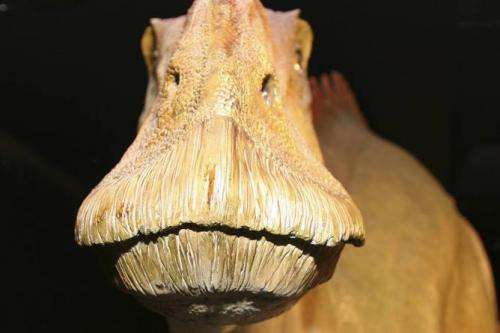Chemical ghosts of dinosaurs may help reveal new secrets

Most of life is carbon-based, that is, organic. These organic molecules containing mostly carbon and hydrogen are delicate to the ravages of time, relatively speaking. They aren't usually preserved in fossils that paleontologists unearth to tell the story of our planet's past. For them, it is vital information lost forever.
Most fossils we know of are the remains of mineralised 'hard parts', like bones or shells. On rare occasions , the fossil record reveals to us a unique window into ancient life.
Some researchers, such as, Mary Schweitzer at the North Carolina State University believe that organic molecules can be preserved for millions of years, entombed within rocks. Her work has involved looking specifically at such preservation in dinosaurs. She and her team use sophisticated tools to tease out traces of these molecules.
They have shown that in dinosaurs, such as Tyrannosaurus rex, it is possible to find structures resembling blood vessels and even the residue of proteins. Analysis of such remains can help us understand dinosaur's physiology – what they ate, how fast they grew, what the colour of their feathers were - the possibilities are potentially endless.
But given the delicate nature of organic molecules that make up tissues, much of the palaeontological community remains sceptical about tissue preservation in fossils. Now a new paper by Schweitzer and her team might help address some of the scepticism.
In this paper, published in the Proceedings of the Royal Society B, Schweitzer shows that, during the process preservation, the conditions can often be "just right" to save tissues - the 'Goldilocks effect'. This process that she calls "tissue fixation" may help paleontologists look at molecular remains that may hold important clues about these beasts. Borrowing a host of analytical tools from Earth and environmental sciences, Schweitzer shows it may be possible to observe the "chemical ghosts" remaining in fossils, and how these have helped to exquisitely preserve molecular structures.
Fixing fossils
For tissue fixation to take place, it needs to happen at a rapid speed – that is, decaying of soft tissues must be slower than fossilisation process. To be sure that tissue fixation was really happening, Schweitzer's team performed the same tests on another dinosaur (Brachylophosaurus canadensis) and on ostrich remains, one of the most primitive birds of the modern era.
In an ostrich, iron accumulates in certain parts of the tissue. According to Schweitzer's analysis, it was these parts that resisted decay for the longest, showing that iron can enhance preservation in modern animals, specifically extant dinosaurs.
In both T. rex and B. canadensis too, iron is found strongly associated with structures like blood vessels and osteocytes (a star-shaped cell found in bones). This provides more evidence that these are actually the exceptional remains of soft tissues, and not some contaminant.
Only a decade ago, this hypothesis would have been laughed at by fellow scientists. While many still remain unconvinced, there is growing evidence that molecular tissues may actually have been preserved. Now the question is: how much have palaeontologists missed by not considering these potentially high levels of preservation in dinosaurs? And how much is there that is still left to be found at such levels of detail?
More information: Mary H. Schweitzer, Wenxia Zheng, Timothy P. Cleland, Mark B. Goodwin, Elizabeth Boatman, Elizabeth Theil, Matthew A. Marcus, and Sirine C. Fakra. "A role for iron and oxygen chemistry in preserving soft tissues, cells and molecules from deep time." Proc. R. Soc. B January 22, 2014 281 1775 20132741; DOI: 10.1098/rspb.2013.2741 1471-2954
Source: The Conversation
This story is published courtesy of The Conversation (under Creative Commons-Attribution/No derivatives).
![]()

















